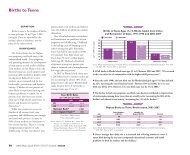2010 Rhode Island Kids Count Factbook
2010 Rhode Island Kids Count Factbook
2010 Rhode Island Kids Count Factbook
Create successful ePaper yourself
Turn your PDF publications into a flip-book with our unique Google optimized e-Paper software.
Chronic Early Absence<br />
DEFINITION<br />
Chronic early absence is the<br />
percentage of children in kindergarten<br />
through third grade (K-3) who have<br />
missed at least 10% of the school year<br />
(i.e., 18 days or more), including<br />
excused and unexcused absences.<br />
SIGNIFICANCE<br />
When students are absent from school<br />
they miss opportunities to learn and<br />
develop positive relationships within the<br />
school community. During the early<br />
elementary school years, children develop<br />
important skills and approaches to<br />
learning that are critical for ongoing<br />
school success. Through their experiences<br />
in K-3 classrooms, children build<br />
academic, social-emotional and study<br />
skills. 1,2 Children who are chronically<br />
absent in kindergarten show lower levels<br />
of achievement in math, reading and<br />
general knowledge in first grade.<br />
Among poor children, chronic absence in<br />
kindergarten can predict low educational<br />
achievement at the end of fifth grade.<br />
Nationally, chronically absent Hispanic<br />
kindergartners have lower reading<br />
achievement than their chronically<br />
absent peers of other ethnicities. 3,4<br />
Nationally, chronic early absence<br />
affects one out of 10 children during<br />
their first two years of school. 5 Younger<br />
children from poor families are much<br />
more likely to have high rates of chronic<br />
absenteeism than higher-income<br />
children. In the U.S., one in<br />
five (21%) poor kindergartners was<br />
chronically absent, compared to less than<br />
one in ten (8%) of their higher-income<br />
peers. 6 Children who are homeless or<br />
formerly homeless also experience poor<br />
educational outcomes related to school<br />
absenteeism and mobility. 7 Lack of access<br />
to preventive health care and chronic<br />
health issues, such as asthma, can result<br />
in increased absenteeism. 8<br />
Chronic early absence is most often a<br />
result of a combination of school, family<br />
and community factors. 9 Risk factors<br />
such as poverty, teenage parenting, single<br />
parenting, low maternal education levels,<br />
unemployment, poor maternal health,<br />
receipt of welfare, and household<br />
food insecurity can all affect school<br />
attendance. Rates of chronic absence rise<br />
significantly when three or more of these<br />
risk factors are present. 10,11 Chronic<br />
absenteeism can also result from poor<br />
quality education, ambivalence about<br />
or alienation from school, and chaotic<br />
school environments, including high<br />
rates of teacher turnover, disruptive<br />
classrooms and/or bullying. 12<br />
Community factors that may disrupt<br />
school routines and lead to chronic<br />
absence include unreliable or insufficient<br />
public transportation systems, violence or<br />
the fear of violence on the way to and<br />
from school, multiple foster care<br />
placements, and lack of access to safe<br />
and affordable housing. 13<br />
School Attendance in <strong>Rhode</strong> <strong>Island</strong> by Number of School Days Missed,<br />
Kindergarten Through Third Grade, 2008-2009 School Year<br />
47% 0-5 Days<br />
30% 6-11 Days<br />
13% 12-17 Days<br />
10% 18 Days or More<br />
n = 45,966<br />
Source: <strong>Rhode</strong> <strong>Island</strong> Department of Elementary and Secondary Education, 2008-2009 school year.<br />
◆ During the 2008-2009 school year, 10% of <strong>Rhode</strong> <strong>Island</strong> children in grades K-3 were<br />
chronically absent (i.e. absent 18 days or more). In <strong>Rhode</strong> <strong>Island</strong>’s core cities, 16% of<br />
children in grades K-3 were chronically absent. 14<br />
◆ Almost one in four (23%) <strong>Rhode</strong> <strong>Island</strong> children in grades K-3 missed 12 or more<br />
days of school during the 2008-2009 school year. 15<br />
◆ Schools may inadvertently overlook the prevalence of chronic early absence because<br />
high rates for school attendance can easily mask significant numbers of chronically<br />
absent students. 16 In <strong>Rhode</strong> <strong>Island</strong> during the 2008-2009 school year, elementary schools<br />
in the core cities had an average daily attendance rate of 93%, but 16% of students in<br />
grades K-3 were chronically absent. 17<br />
◆ While most elementary schools monitor average daily attendance or unexcused absences,<br />
few actively monitor the combination of excused and unexcused absence for individual<br />
students. 18 Schools can promote attendance by helping parents understand that coming<br />
to school, especially in the early grades, is critical to children's academic success. 19<br />
◆ Chronic absenteeism rates can be reduced through school-family-community<br />
partnerships that use an ongoing and intentional approach for monitoring attendance<br />
and contacting parents as soon as troubling patterns of attendance appear. 20 Schools and<br />
communities can address the problem of chronic absence through existing initiatives on<br />
parent involvement, school readiness, after-school programming, school-based health<br />
services, and drop-out prevention. 21<br />
13%<br />
30%<br />
10%<br />
47%<br />
144 <strong>2010</strong> <strong>Rhode</strong> <strong>Island</strong> KIDS COUNT <strong>Factbook</strong> / Education






